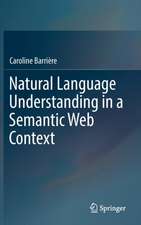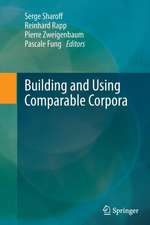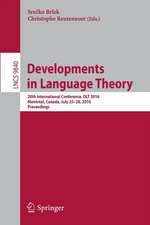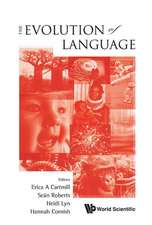Reversible Grammar in Natural Language Processing: The Springer International Series in Engineering and Computer Science, cartea 255
Editat de T. Strzalkowskien Limba Engleză Hardback – 30 noi 1993
Most papers collected in this volume are derived from presentations at a workshop held at the University of California at Berkeley in the summer of 1991 organised under the auspices of the Association for Computational Linguistics.
This book will be a valuable reference to researchers in linguistics and computer science with interests in computational linguistics, natural language processing, and machine translation, as well as in practical aspects of computability.
| Toate formatele și edițiile | Preț | Express |
|---|---|---|
| Paperback (1) | 1280.69 lei 6-8 săpt. | |
| Springer Us – 12 oct 2012 | 1280.69 lei 6-8 săpt. | |
| Hardback (1) | 1287.12 lei 6-8 săpt. | |
| Springer Us – 30 noi 1993 | 1287.12 lei 6-8 săpt. |
Din seria The Springer International Series in Engineering and Computer Science
- 24%
 Preț: 1041.98 lei
Preț: 1041.98 lei - 20%
 Preț: 643.50 lei
Preț: 643.50 lei - 18%
 Preț: 1225.62 lei
Preț: 1225.62 lei - 18%
 Preț: 965.02 lei
Preț: 965.02 lei - 20%
 Preț: 646.12 lei
Preț: 646.12 lei - 18%
 Preț: 948.79 lei
Preț: 948.79 lei - 20%
 Preț: 646.62 lei
Preț: 646.62 lei - 15%
 Preț: 637.46 lei
Preț: 637.46 lei - 20%
 Preț: 643.83 lei
Preț: 643.83 lei - 18%
 Preț: 949.23 lei
Preț: 949.23 lei - 20%
 Preț: 644.48 lei
Preț: 644.48 lei - 20%
 Preț: 994.92 lei
Preț: 994.92 lei - 20%
 Preț: 645.97 lei
Preț: 645.97 lei - 18%
 Preț: 946.87 lei
Preț: 946.87 lei - 20%
 Preț: 995.57 lei
Preț: 995.57 lei - 18%
 Preț: 956.99 lei
Preț: 956.99 lei - 20%
 Preț: 644.98 lei
Preț: 644.98 lei - 15%
 Preț: 649.54 lei
Preț: 649.54 lei - 18%
 Preț: 950.21 lei
Preț: 950.21 lei - 18%
 Preț: 1221.38 lei
Preț: 1221.38 lei - 18%
 Preț: 957.62 lei
Preț: 957.62 lei - 15%
 Preț: 643.99 lei
Preț: 643.99 lei - 18%
 Preț: 948.47 lei
Preț: 948.47 lei - 18%
 Preț: 947.35 lei
Preț: 947.35 lei - 20%
 Preț: 1284.65 lei
Preț: 1284.65 lei - 20%
 Preț: 1628.31 lei
Preț: 1628.31 lei - 20%
 Preț: 1285.78 lei
Preț: 1285.78 lei
Preț: 1287.12 lei
Preț vechi: 1608.90 lei
-20% Nou
Puncte Express: 1931
Preț estimativ în valută:
246.30€ • 263.37$ • 205.35£
246.30€ • 263.37$ • 205.35£
Carte tipărită la comandă
Livrare economică 17 aprilie-01 mai
Preluare comenzi: 021 569.72.76
Specificații
ISBN-13: 9780792394167
ISBN-10: 079239416X
Pagini: 454
Ilustrații: XXI, 454 p.
Dimensiuni: 170 x 244 x 27 mm
Greutate: 0.84 kg
Ediția:1994
Editura: Springer Us
Colecția Springer
Seria The Springer International Series in Engineering and Computer Science
Locul publicării:New York, NY, United States
ISBN-10: 079239416X
Pagini: 454
Ilustrații: XXI, 454 p.
Dimensiuni: 170 x 244 x 27 mm
Greutate: 0.84 kg
Ediția:1994
Editura: Springer Us
Colecția Springer
Seria The Springer International Series in Engineering and Computer Science
Locul publicării:New York, NY, United States
Public țintă
ResearchCuprins
Contributors.- Preface.- 1 A Reversible Constraint-based Iogic Grammar: Application to the Treatment of Secondary Predication and Small Clauses.- 1 Introduction.- 2 A type-based description language.- 3 Dealing with constraints.- 4 Processing Language with types and constraints.- 5 An abstract machine for type construction in a parsing process.- 6 An Abstract Machine for Language Generation.- 7 An Application to Secondary Predications and Small Clauses in Portuguese.- 8 Specific features of our approach.- 9 Conclusion.- 2 Inherently Reversible Grammars.- 1 Introduction.- 2 Definite programs and computation.- 3 Grammars and their computational uses.- 4 Definite programs, uniformity of implementation, and reversibil-ity.- 5 Inherently reversible grammars.- 6 Some counter-examples to finite reversibility and a “modera-tion” condition on linguistic description.- 7 Appendix.- 3 Reversibility and Self- Monitoring in Natural Language Generation.- 1 Introduction.- 2 Reversible grammars.- 3 Modularity in Generation Systems.- 4 Integration of Parsing and Generation.- 5 Generation of Unambiguous Utterances.- 6 Generation of Paraphrases.- 7 Discussion.- 8 Future work.- 4 A Uniform Architecture For Parsing, Generation and Transfer.- 1 Principles for a uniform architecture.- 2 A rewrite machine for typed feature structures.- 3 Parsing, generation, and bidirectional transfer.- 4 The termination problem and efficiency issues.- 5 Conclusion.- 5 Handling Felicity Conditions With A Reversible Architecture.- 1 Introduction.- 2 Felicity Conditions for a Reversible Architecture.- 3 A Data Structure for a Reversible Architecture.- 4 Towards a New Reversible Architecture.- 5 Discussion.- 6 Conclusion.- 6 Common Heuristics for Parsing, Generation, and Whatever.- 1 Introduction.- 2Constraint Network.- 3 Computation.- 4 Parsing.- 5 Generation.- 6 Concluding Remarks.- 7 Compiling Trace & Unification Grammar.- 1 Introduction.- 2 Formalism.- 3 Compiling Trace & Unification Grammar.- 4 Conclusion.- 8 A General Computational Method for Grammar Inversion.- 1 Reversible Grammars.- 2 In and Out Arguments in Literals.- 3 Essential Arguments: An Extension.- 4 Intra-Clausal Inversion.- 5 Moving Literals Between Clauses.- 6 Inter-Clausal Inversion.- 7 Conclusions.- 9 Bi-Directional Preferences.- 1 Introduction.- 2 Basic Definitions.- 3 An Algorithm.- 4 Some Examples of Preferences.- 5 Extensions: Complex Preferences.- 6 Bi-Directional Preferences.- 7 Conclusion.- 10.Handling Syntactic Alternatives in A Reversible Grammar.- 1 Introduction.- 2 The Grammar Formalism and Thematic System.- 3 Discourse Parameters.- 4 How the discourse parameters are encoded in the grammar.- 5 Some Examples.- 6 Discussion.- 7 Conclusions.- 11 Reversible Nlp by Linking the Grammar to The Knowledge Base.- 1 Introduction.- 2 Reversibility through compilation.- 3 The ‘pivot-point’ between generation and comprehension.- 4 Parsing to objects.- 5 Linking linguistic resources to objects.- 6 Summary of the approach.- 7 Parsing Tree Adjoining Grammars.- 8 Exploded Tree Families.- 9 An example of the objects recovered by a parse.- 10 Is it Still a TAG?.- 11 Concluding remarks.- 12 Reversible Grammars and Their Application in Machine Translation.- 1 MT as Knowledge Description.- 2 Grammar Reversibility.- 3 ELU.- 4 Description of the Grammar.- 5 Conclusion.- 13 Reversible Machine Translation: What to Do When the Languages Don’t Match Up.- 1 Introduction.- 2 Translation Divergences and Mismatches.- 3 Viewing the Problem as One of Generation.- 4 The Role of the Knowledge Base.- 5 DefiningWhat it Means to be a Correct Rendition of an Input.- DLSS.- 6 A Closest-Fit Generation Algorithm.- 7 Heuristic Improvements.- 8 Conclusion.- 14 A Generationist Approach to Grammar Reversibility in Natural Language Processing.- 1 The ‘formal linguistics’ approach to the issue.- 2 The argument in a nutshell.- 3 Some supporting evidence: the different problems of processing in the two directions.- 4 The linguistic archipelago.- 5 Fleshing out the argument: overview of a complete system.- 6 Generators derived from parsers: a discussion.- 7 Conclusions.- 15 Semantic Interpretation in a Systemic Functional Grammar.- 1 Introduction.- 2 What About Syntax?.- 3 Overview.- 4 Finding the Features.- 5 Disjunction: Inclusive, Exclusive or Both?.- 6 Conclusions.




















